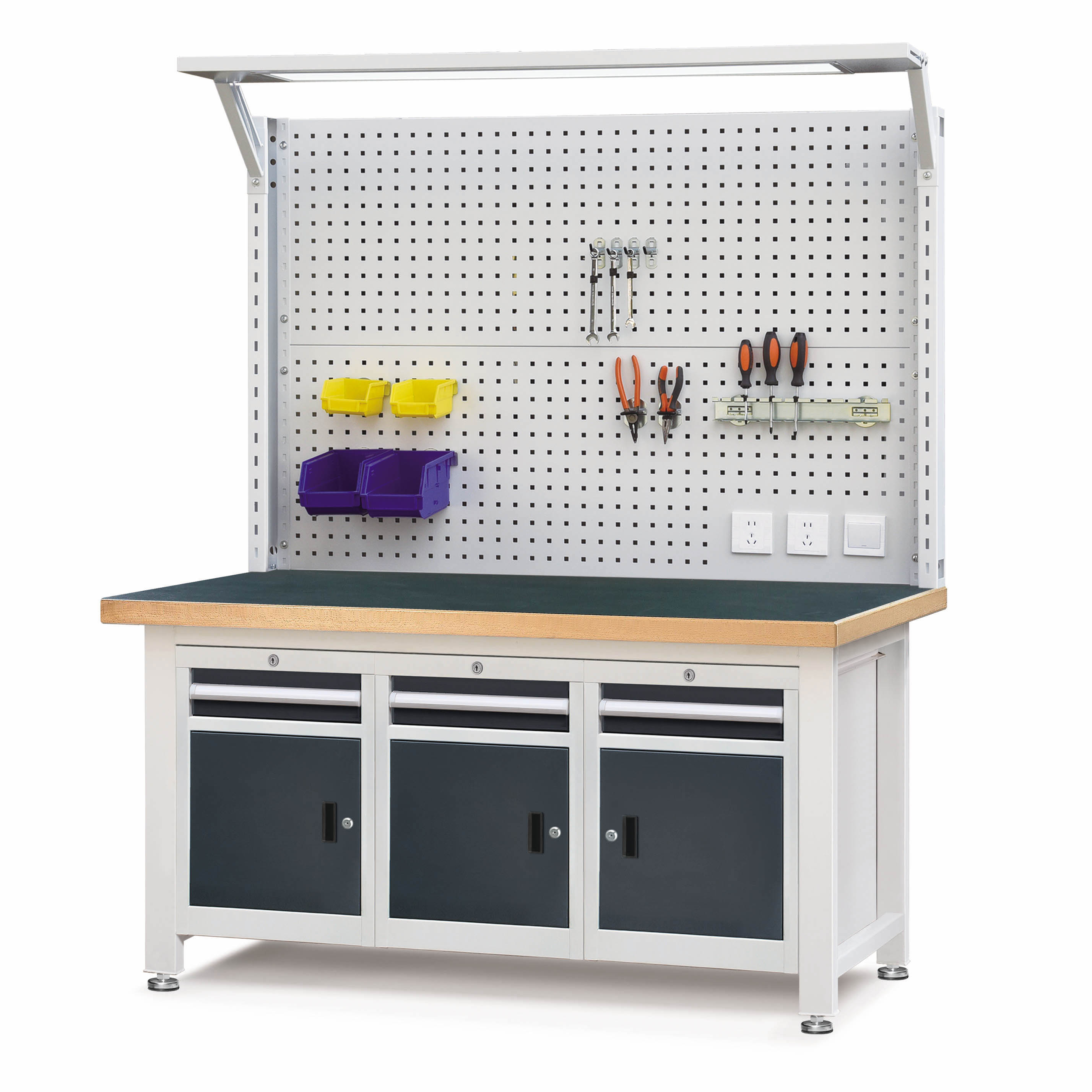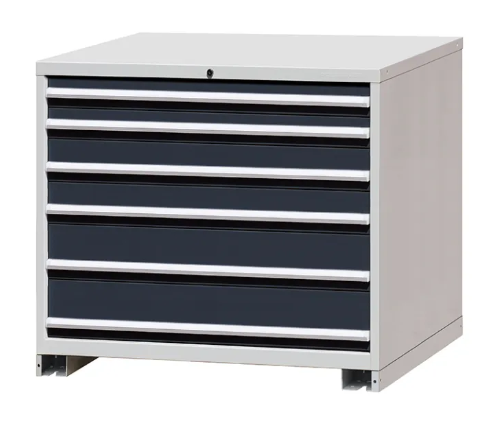ROCKBEN is a professional wholesale tool storage and workshop furniture supplier.
How To Choose Between Tool Cabinets And Tool Workbenches
Selecting the right storage and workspace solution for your tools is crucial for efficiency and organization. But with so many options available, how do you choose between a tool cabinet and a tool workbench? This guide breaks down the key differences and helps you make an informed decision.
Distinguishing Tool Cabinets From Tool Workbenches
While both tool cabinets and tool workbenches play essential roles in a workshop, understanding their distinct functions is crucial for making informed decisions. Let's examine their core differences:
Tool Cabinets: Optimized for Secure Storage
Tool cabinets prioritize the organization and protection of your valuable tools. These units typically feature numerous drawers and compartments, allowing for the methodical arrangement of everything from hand tools to power equipment.
● Key Characteristics: Multiple drawers, robust construction, secure locking mechanisms, and often, integrated mobility features such as casters.
● Optimal Applications: Maintaining a well-organized and secure tool collection, safeguarding tools from damage or theft, and ensuring easy access to equipment.
Tool Workbenches: Designed for Enhanced Workspace Functionality
Tool workbenches, conversely, center on providing a stable and functional work surface. They commonly incorporate a spacious worktop, and integrated vises for securing workpieces, and may include built-in power outlets for convenient tool usage.
● Key Characteristics: Durable work surface, heavy-duty construction, vises for workpiece stability, and frequently, supplementary storage options like shelves or drawers.
● Optimal Applications: Conducting hands-on projects, performing repairs, and undertaking DIY tasks that require a dedicated and practical workspace.
Factors To Consider Before Buying
Choosing between a tool cabinet and a tool workbench is a big decision for any industrial manufacturing. It's not just about storing your tools; it's about optimizing your workflow and making your projects easier. To help you make the right choice, let's break down the key factors you should consider:
1. Space and Layout
Think of your workshop as a bustling city. Just as a city needs proper planning to avoid traffic jams, your workshop needs a strategic layout. Before you even start browsing for tool storage, take a good look at your space.
● Measure everything: Grab your tape measure and record the dimensions of your workshop. Consider doorways, windows, and existing equipment. This will help you determine the maximum size of your new tool cabinet or workbench.
● Visualize the workflow: Imagine yourself moving around your workspace. Where would a workbench be most convenient? Would a mobile tool cabinet offer more flexibility? Consider how the placement of your new addition will impact your overall efficiency.
2. Project Type and Workflow
The type of work you do will heavily influence your choice.
● Project Focus: Woodworkers often need ample surface area for cutting and assembling, while mechanics might prioritize drawer space for small parts and specialized tools. Think about the specific demands of your projects.
● Workflow Optimization: Do you prefer to have all your tools within arm's reach while you work, or do you value a dedicated space for assembly and finishing? Consider how your workflow can be enhanced by the right tool storage and workspace solution.
3. Budget
Tool cabinets and workbenches can range from affordable to expensive. Setting a clear budget will help you narrow down your options and avoid overspending.
● Set Realistic Expectations: Determine how much you're comfortable investing in your workshop upgrade. Remember to factor in potential shipping costs and any necessary accessories.
● Prioritize Features: Focus on the features that are most important to you. If you're on a tight budget, you might opt for a basic workbench and gradually upgrade with additional storage solutions as needed.
4. Storage Needs
Take an inventory of your tools. Are you mostly dealing with hand tools, or do you have a growing collection of power tools? Do you need specialized storage for small parts or delicate instruments?
● Categorize Your Tools: Group similar tools together to get a better understanding of your storage requirements. This will help you choose a unit with the right drawer sizes and configurations.
● Plan for the Future: Don't just consider your current tool collection. Think about your future needs. Are you planning to expand your toolset? Choose a storage solution with some room to grow.
5. Material and Construction
Your tool storage and workspace should be as tough as the jobs you tackle. Pay close attention to the materials used and the overall construction quality.
● Material Matters: Steel is a popular choice for its durability and resistance to damage. Hardwood offers a classic look and can withstand heavy use. Consider the pros and cons of each material.
● Inspect the Details: Look for sturdy construction, reinforced joints, smooth-gliding drawers, and a stable work surface. A well-built unit will provide years of reliable service.
Expert Advice On Choosing The Right Option
You've measured your space, analyzed your workflow, and dreamt of the perfect workshop setup. Now, let's get down to brass tacks. Here's some expert advice to help you make the final decision:
1. The Hybrid Approach: Best of Both Worlds
Who says you have to choose just one? For ultimate flexibility and functionality, consider combining a tool cabinet and a workbench. This dynamic duo allows you to keep your tools organized and secure while having a dedicated workspace for your projects.
● Modular Systems: Explore modular tool storage systems that offer a combination of cabinets, drawers, and work surfaces. These systems can be customized to fit your specific needs and expanded as your tool collection grows. Imagine it like building with LEGOs – start with a base unit and add components as your needs evolve.
● Mobile Workbenches: A mobile workbench with built-in storage can be a game-changer for smaller workshops. You get the benefits of a sturdy work surface and ample storage in a compact and maneuverable unit. This is like having a workshop on wheels, ready to be deployed wherever you need it.
2. Prioritize Ergonomics: Work Smarter, Not Harder
Your workshop should be a place where you can work comfortably and efficiently. Consider the ergonomic aspects of your tool storage and workspace. After all, nobody wants a sore back after a productive day of tinkering.
● Workbench Height: Choose a workbench height that allows you to work with a straight back and relaxed shoulders. An adjustable-height workbench can be a worthwhile investment, especially if multiple people will be using it. Think of it like Goldilocks finding the perfect chair – not too high, not too low, but just right.
● Drawer Accessibility: Ensure that drawers open smoothly and provide easy access to your tools. Look for features like full-extension drawer slides and soft-close mechanisms. Nobody wants to wrestle with a stubborn drawer when they're in the middle of a project.
● Lighting: Adequate lighting is essential for any workspace. If your workshop has limited natural light, consider adding task lighting to your workbench or tool cabinet. Good lighting not only improves visibility but also reduces eye strain and fatigue. Think of it as giving your eyes a helping hand.
● Anti-Fatigue Mats: If you spend a lot of time standing at your workbench, consider investing in an anti-fatigue mat. These mats provide cushioning and support, reducing strain on your feet, legs, and back. It's like giving your feet a mini-vacation while you work.
3. Think Long-Term: Invest in Quality
A well-made tool cabinet or workbench is an investment in your craft. Don't skimp on quality just to save a few bucks. Think of it like buying a good pair of boots – they might cost more upfront, but they'll last longer and provide better support in the long run.
● Durable Materials: Choose units made from high-quality materials that can withstand the rigors of daily use. Steel, hardwood, and heavy-duty plastic are all good options. Think of it as choosing the right armor for your workshop warriors.
● Reliable Construction: Look for sturdy construction with reinforced joints, smooth-gliding drawers, and a stable work surface. A well-built unit will provide years of reliable service. You want something that can handle a few bumps and bangs without falling apart.
● Warranty and Support: Check the manufacturer's warranty and customer support options. A good warranty can give you peace of mind and protect your investment. It's like having a safety net for your tools and equipment.
● Reviews and Recommendations: Before making a purchase, take some time to read online reviews and seek recommendations from other DIYers or professionals. This can give you valuable insights into the pros and cons of different brands and models. Think of it as tapping into the collective wisdom of the workshop community.
Making The Right Choice For Your Workshop
Selecting appropriate tool storage and workspace solutions is a critical decision for any DIYer or professional craftsperson. By carefully evaluating your needs and priorities, you can cultivate a workshop environment that promotes productivity, efficiency, and a fulfilling work experience.
When making your decision, remember that tool cabinets excel in the secure storage and organization of tools, while tool workbenches prioritize workspace functionality and ergonomics. Consider a hybrid approach, incorporating both for a truly versatile and adaptable workspace.
Prioritize ergonomics and long-term value by choosing well-constructed units made from durable materials. Invest in your craft and create a workspace that empowers you to tackle any project with confidence and unwavering focus.

Tel: +86 13916602750
Email: gsales@rockben.cn
WhatsApp: +86 13916602750
Address: 288 Hong An Road, zhu jing Town, Jin Shan districtrics, shanghai, china










































































































